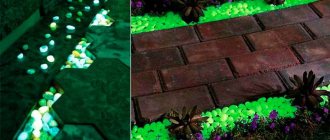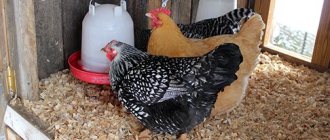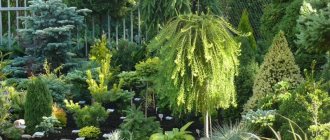You can use luminous stones to decorate your home or garden interior. During the day, they simply look like a beautiful decoration for a flower bed or path, and at night they are a source of light. Stones can be purchased at a specialized store or made independently.
Glowing stones, beauty in lighting
There are many legends about luminous stones, it is possible that everything that is said about them is just a fairy tale, but looking at all this beauty, especially at night, you involuntarily think that a fairy tale can become a reality, the main thing is to want it.
For example, there is a myth about the stone of Heraclea. It talks about a woman who lost her beloved husband and suffered for him.
One day, a young stork, weakened by the flight, fell in front of her. She came out and cured him. As soon as the bird recovered, the woman released it into the wild. A year later, the same stork flew again. Flying over Heraclea, he dropped a stone, which the woman took home. At night, she woke up from a strange light hitting her eyes. The light came from the stone with which the stork thanked the woman; it illuminated the entire room, like thousands of small lamps.
Very beautiful
The same luminous stones are mentioned in the stories about Noah's Ark. It is believed that Noah took them with him; during the day they shone brighter, and it was through them that they recognized the time of day, since during the flood neither the moon nor sunlight was visible.
In many fairy tales, you can find kings who found luminous stones and crowned their crowns with them, it was believed that such a stone endowed them with great power.
There are a lot of such legends, but the essence is the same: such stones not only glow, they have a positive effect on a person’s mood.
In the modern world, decorating a garden with luminous stones is considered an innovation. Glowing stones for the garden are a very original type of outdoor lighting; they can be used in the following ways:
- you can line garden paths and flower beds with them;
- lay out the sides of ponds and fountains;
- due to their environmental friendliness, they can be used in aquariums and placed directly into the water in swimming pools;
- small pebbles can be used to frame photo frames, make jewelry, and decorate interior items;
- design entertainment venues.
Glow in the dark marble chips
We create beauty with our own hands ↑
Before you make luminous stones with your own hands, you need to decide what you will decorate with them in order to choose the right shape and size. In order not to rack your brains about which brand of blanks is best to buy, you can use natural material - ordinary cobblestones or pebbles. In addition, you will need TAT33 light-accumulating paint to paint your pebbles. The dried surface can be used immediately. Glowing paint does not deteriorate even in a humid environment, so it is often used to decorate the bottom of decorative ponds and aquariums. The paint is also environmentally friendly and safe for people and animals. You can safely paint interior items with it.
With this paint for concrete surfaces, you can make entire glowing borders, and this is a good way to decorate the area without spending a lot of money. If you want to make luminous paving slabs, you need to cover them after laying them. But if you need to make a flowerbed of stones or a border, you first need to paint them and dry them.
Glowing stones have become an indispensable item for landscape design. Experts divide them into three types, which depend on the size: crumbs (about 5 mm in diameter), river pebbles (1-2 cm) and boulders (27x17 cm). These standards come from manufacturers of finishing materials, so you do not have to measure each workpiece with a ruler and generally adhere to specific numbers. After all, you create comfort for yourself, which means you choose the size and shape of the stones yourself.
You can decorate your home with glowing stones not only on the outside, by gluing them onto the finishing tiles. If you want to decorate the inside of the house, then you need to apply a construction mesh onto the freshly plastered wall, onto which pre-painted stones are glued. Empty spaces between the stones are carefully rubbed over with plaster. Ceiling tiles can also be framed with luminous chips.
Making glowing stones often turns into a hobby. Even if you have already decorated everything possible with them, your hands reach for paint again and again. In such cases, people begin to study art more deeply and even find a way to make good money. So it makes sense to work.
Choice of material (stone)
There are two types of stones: natural and artificial. Artificial ones are lighter in weight and, accordingly, easier to transport, and also do not have such disadvantages as the presence of cracks and bacteria, like natural ones. However, a large number of people prefer natural stones, although they require more careful preparation before painting.
One of the types of natural stones used as luminous stones for landscape design is pebbles. This stone has a beautiful round shape and a smooth surface. Before painting the stone, it must be washed thoroughly, all cracks removed from dirt and dried, since the quality of the finished design element will depend on the purity of this material.
Stones with luminosity catalysts
The material for such luminous stones is a special polymer plastic with luminosity catalysts. It is these additives that can accumulate light from absolutely any source, for example, from the sun, moon, or even an ordinary light bulb. Therefore, the glow of such a stone, of course, cannot be endless - it lasts exactly as long as its stay in the light lasted. Let’s say that if an artificial stone lay under the rays of the sun all day, then it will glow all night until dawn. Well, if the “recharging” lasted only 30 minutes, then after the next half hour the glow of the stone will completely dry up. The service life of such products is practically unlimited, as is the number of light “recharges”.
Self-luminous stones on the path day and night
Manufacturers produce self-luminous stones in three sizes: small (no larger than stone chips), medium (like river pebbles) and large (similar to boulders).
To install small and medium stones on the site, you don’t need any special wisdom - just scatter them in the desired places. Artificial boulders must be carefully fixed to the soil so that they are not blown away by gusts of wind. For this purpose, each such stone has a cavity that is not closed from below. Installation occurs as follows: a polymer boulder is placed in the selected location and pressed firmly with your hands so that the edges of the cavity partially go underground. It is first recommended to place foil or a piece of white paper inside the stone to enhance the quality of the glow.
How to make a glowing stone
Many people who like to recreate their favorite beauties in practice with their own hands will be interested in how to make luminous stones. Indeed, you don't need to buy them at all. You just need to prepare some natural or artificial stones. They are coated with TAT33 paint, which also has light-accumulating properties, and its light will last for 9 hours. After the paint has dried on the surface, the stone is ready for use. Conveniently, this paint perfectly tolerates too much humidity, which makes it possible to decorate aquariums, decorative ponds and swimming pools with stones painted with it. Glowing paint is absolutely safe for humans and animals, so you can freely paint any home interior items with it. A paint has been created for concrete surfaces, which allows you to paint borders with it. Since the paint is not prone to abrasion and washing off, its long service life makes this method of decoration quite economical. such luminous stones with your own hands quite quickly, and even faster you can place them on the territory to be decorated.
First, prepare the paint and clean the stones well.
Use a brush or sponge to apply paint to the stones.
Leave the stones to dry for several hours and then decorate your home.
By the way, stones for fencing a flower bed or creating a border are first painted, and only then, after drying, are placed in place. But the paving slabs are covered with luminous paint after installation. An important requirement is to coat only dry, clean surfaces with luminescent paint. After the paint has completely dried, you can also coat the stones with a varnish intended for outdoor use, for example, yacht varnish.
This is what the stones will look like in the dark.
Path with glowing crumbs during the day...
Such stones have a very high decorative effect, and they provide light at night for many years. Thanks to luminous stones, you can create crafts for your yard or garden with your own hands without spending a lot of effort and money. It is also consoling that such homemade glowing stones for an aquarium are natural and therefore absolutely safe. Both stones and paint will not cause any harm to the inhabitants of an artificial pond, but the visual effect of their presence in a pond, aquarium or pool is simply amazing.
Painting
After preparing the stone and choosing paint, you can begin painting. Making stones that glow in the dark is very simple. You need to take a brush and apply paint to the stone. To save paint itself and reduce painting time, it is recommended to apply paint only to the outer part of the stone, since the rest will be in the ground and will become invisible to the eye. Already painted stones should be laid out on a previously prepared flat surface (put a clean sheet of paper or a piece of fabric on it) so that they can dry sufficiently before laying them out on the landscape. If it is a natural stone, it is necessary to carefully paint over all the cracks and crevices.
Now the time has come to decorate the site with your own hands. There are many ready-made ideas on how to do this. You can lay luminous stones along the path, then they will be its outline, or you can make a path from the luminous stones themselves. Due to the fact that stones are moisture resistant, they can be used to decorate swimming pools, fountains, and ponds. Glow-in-the-dark stones are spectacular and easy to make, even with your own hands. Every ordinary gardener can become a real artist and landscape designer in their own area. The variety of colors of stones gives incredible flight to fantasies, which every person can turn into reality and become a little bit of a wizard, creating a fairy tale with their own hands.
Source: www.liveinternet.ru
Technology for making glowing stones
We make luminous stones with our own hands. To evenly apply the coloring composition to small and medium-sized cobblestones, it is better to use a fill. The coloring composition is diluted in a special container. You need to prepare a place for drying in advance. The stones should not be placed on the site until completely dry. Dust particles will be absorbed into the surface and dry out. This will reduce the glow effect. It will be impossible to wash away dust and dirt.
The brush is used to paint large decorative details: boulders, cobblestones, tiles, borders. This is a more accurate way of applying the composition. You can use a regular brush to paint windows.
A spray can is used less frequently. It is impossible to paint a mass of pebbles or crumbs with it. The coloring will be uneven and complex. The can is suitable for point distribution of the coloring composition on a flat surface. It can also be used to apply an additional layer to small stones after pouring and drying.
Take precautions with any type of painting.
- Avoid contact of the composition with eyes, clothing and skin.
- Use rubber gloves.
- Keep away from children.
- Use outdoors or in a well-ventilated area.
Dimensions and installation features
Manufacturers produce stones that can glow in the dark in three sizes: small (like stone chips), medium (no larger than river pebbles) and large (resembling boulders).
To install small or medium-sized pebbles on a site, you do not need any training or skills. To achieve an aesthetic effect, simply scatter them in selected places. But artificial boulders require more thoughtful handling. They must be carefully fixed to the ground, otherwise they may be blown away by gusts of wind. For this purpose, each product has a cavity that is not closed from below. The installation is carried out as follows: a polymer boulder is placed at the selected location, pressing it firmly with your hands so that the edges of its cavity go partially underground. It is recommended to place foil or a piece of white paper inside the stones before laying them, this will enhance the quality of their glow.
Decoration examples
Contour framing of objects
A luminous object looks beautiful both up close and from a long distance, or from a height. If you like to go out onto the balcony in the evening, you will certainly enjoy the flowerbed, which is framed along the contour by luminous stones. Contour edging also works well for walkways and ponds.
Contour frame of the path using green luminous pebbles
Spectacular contour framing of flower beds and nearby objects in a gravel garden. The stones can be laid out in a solid line so that the outline is clearly visible, and in the middle the stones can be placed at some distance from each other
Dot Framing
If with a contour frame the mound of stones is almost continuous, then with a dot frame they are used much less, and the light of each pebble is visible separately. For many, this type of decoration and lighting is preferable - individual stones look more impressive, and only a few are required. Some people like this dotted pattern of multi-colored stones along the path, others prefer a luminous strip of single-colored stones.
Spot lighting of the path with multi-colored stones. Such lighting in the garden can also be arranged if you are gathering guests for a holiday - they can surround a gazebo, fountain, benches
Spot lighting with stones of the same color. Large luminous semicircular stones are a complete replacement for lanterns, but lighting costs will be lower
A single object to highlight a small composition
If the garden is small, one large glowing boulder will look very good, highlighting a bush, tree or other object. Its light will be softer and more mysterious than the light of a lantern.
Large configurations of stones today can only be found made of polyethylene and with a lamp inside
Patterns of glowing stones
Stones with LEDs are used to create patterns. Their flat shape and durable material allow you to walk on them; you can even create paths of a certain shape from them, which will look especially beautiful in the dark from above. There are also special stones that can be placed in the water and create glowing paths through a small stream or shallow pond.
Path made of translucent stones with LEDs. With the help of such stones you can lay out a pattern in one or several rows
A path of glowing stones in a pond can be either purely decorative or a real path that you can walk along. For this, special durable stones are used.
Physico-chemical properties of fluorite
Chemical formula – CaF2. The color of the crystals is colorless, pink, yellow, blue, green of all shades, violet. The coloring is often uneven; specimens are spotted and striped. Beautiful shades of fluorite are given by admixtures of chlorine, iron, as well as thorium, uranium and other rare earth elements. Hardness – 4 on the Mohs scale. Density – 3.2 g/cm3. The fracture is stepwise. The luster of the stone is glassy. It can be transparent or translucent. The stone has a unique property - its crystals glow in the dark... Bright, transparent and multi-colored fluorites can sometimes be confused with other crystals, especially fluorites of purple shades, which are similar to amethyst. Depending on the color, fluorite can be similar to topaz and even ruby or sapphire. But distinguishing it from other minerals will not be difficult, since fluorite can be easily scratched by glass. Varieties of fluorite are determined depending on the chemical composition and color of the stone: 1. Antozonite (rich and deep purple color) 2. Chlorophane (emerald), 3. Ratovkite (almost lilac or pinkish)
4. Yttrofluorite (yellow shades) The stone is often polychrome (multicolored). One of the unique properties of fluorite is luminescence. It was thanks to this stone that this phenomenon was identified and studied. Imagine your earrings, rings and beads glowing in the dark. By the way, glowing in the dark after exposure to heat or ultraviolet light is another property by which fluorite can be distinguished from other stones.
Processing and use
Fluorite does not always end up on the jeweler's table. It is used in its raw form as part of fluorspar to produce hydrofluoric acid, used in the aluminum industry. Feldspar is also needed to produce hydrogen fluoride. Lenses for night vision devices are made from fluorite. But today the fashion for decorative crafts and jewelry made from fluorite is returning. Beads, bracelets, inserts in rings and earrings, pendants, and various souvenirs appear on store shelves. After all, you know that designers, striving for unusualness, today use fabrics that shimmer in various color shades, including shimmer fabrics, photochromic fabrics, as well as a variety of reflective and luminous elements that adorn the outfits of fashionistas. Gradient on fabric, and therefore in clothing, is another fashion trend. And if so, then the gem should take its rightful place in your outfits and in your jewelry box. The price of fluorite will allow you to do this. The stone is often processed in the form of cabochons.
Glowing stones: original lighting of the evening garden
Who among the owners of summer cottages has not dreamed of decorating their garden with original decor, finding a “zest” that would make the garden unique? I also really want design solutions to be not only beautiful, but also practical. In search of unusual decorations for the garden, many people use proven products, but these days it is worth paying attention to new items. One of them is glowing stones - an extremely interesting garden decor, which also helps solve the problem of lighting the area.
Properties and characteristics
The products themselves come in three types:
- boulders - they are used to lay out ponds, cover flower beds, borders, flower beds;
- river pebbles - such small pebbles can be used when laying out borders, they are very convenient when lighting a path to any building, during the day they manage to charge with sunlight, and at night they illuminate the area quite intensively; you can divide the territory with such stones, then you will not get lost at night;
- chit.
Large forms Composition of luminous stones and properties:
- glowing powder TAT33;
- transparent heavy-duty plastic.
These components are mixed, and the resulting composition is poured into special molds. Thanks to this mixture, the stones become very durable and do not react to weather changes. They have a glossy or matte surface.
Glowing stones in the garden
Every gardener dreams of creating a fairy tale, albeit a small one, out of his country plot. All kinds of flowers, decorative ponds, bushes, clay figurines, paths laid out from various slabs and stones. All this pleases the eye throughout the whole day. What if we make this fairy tale continue at night? Stones that glow at night are just what you need to add a little romance to your landscape design.
Glowing ones are not only a way to decorate an area, but also to illuminate it. With them there is no need to install a large number of lights that consume electricity.
Glow in the dark stones
Not natural stones
There are plastic ones in which powder is added at one of the stages of their manufacture, thanks to which it accumulates solar energy during the day and releases it in the form of a glow at night. They do not require special care and are heat-resistant to both heat and cold, moisture-resistant, and absolutely safe for people and animals. For care you do not need any special detergents; ordinary ones are also suitable; they can be of different sizes, in fact, just like in nature.
The principle of operation of miracle stones ↑
Initially, such stones were made of plastic and filled with luminous paint. But at home, the blanks are coated with acrylic paints with a luminescent effect. This paint has a glossy or matte surface that cannot be washed off or faded. During the day, the luminescent surface, like a battery, accumulates sunlight and begins to emit it when night falls. Therefore, such stones are very popular not only in decorating small things, but also in landscape design. They look great in summer flower beds and along the banks of a pond. A glass vessel filled with such stones looks very original. It can be used not only as decoration, but also as a lamp.
The big advantage of such stones is that they are charged not only from sunlight. This can be done with a flashlight or a simple lighter, so if the weather is gloomy, this does not mean that the stone will not glow at night. A large palette of colors makes it possible to decorate any room with stones, while fitting into its design.
Features of this decor
Since the stone is made from artificial materials in factories, the manufacturer can give it any shape and any size. For example, for interior design they use a variety of small stones that glow in the dark, and for laying out garden paths you can create custom fluorescent tiles, or lay out large decorative stones along the path that glow in the dark.
The second advantage of such unusual lighting is the elimination of electricity or its significant savings if LEDs are built into the luminous stones. An area where the paths are lined with glow-in-the-dark cobblestones will be illuminated at night, regardless of whether there is electricity or not, and the creation of decorative lighting for the area will not affect the light bill.
Polymer with LEDs
Artificial decor containing LED lighting inside is very effective. They are a hollow, durable structure. There is an electronic circuit inside: a photocell plus an LED. The body of artificial stones can be collapsible or monolithic. In the first case, there is the possibility of replacing parts.
As a result, this type of stone creates a brighter and more colorful backlight. To make paths, materials of different shades of light are often used. Polymer materials have several advantages:
- attractive appearance;
- you can purchase different shapes of stones;
- wide range of sizes;
- looks brighter than previous options.
On a note! In the cold season, LED stones do not hold a charge well, so at night they can create quite dim lighting.
How to make fluorescent design elements
You can make the simplest and cheapest option yourself - colored minerals. To do this you will need pebbles, a container and fluorescent paint.
Painting each pebble with a brush is time-consuming and labor-intensive, especially if they are small. It is more convenient to use a spray bottle or pouring method. Before painting, the pebbles must be thoroughly washed and dried.
When painting with a spray gun, you need to spread the minerals on a flat surface. Cover one side with dye and wait until completely dry. Turn them to the other side and cover them with paint. The dye should be sprayed evenly so that it does not form streaks.
For pour painting you will need a container. Clean, dried stones are placed in it and filled with dye. The pebbles should only be lightly coated with paint.
Use a clean stick to mix the minerals so that they are evenly colored. If necessary, you can add a little more dye. Then the pebbles are poured out of the container and allowed to dry.
Isolating decorative elements and creating an ensemble
Dyes with phosphor are useful when restoring furniture and decorating some interior elements. For example, you can paint the entire chandelier or some of its elements, use a transparent base, improve the design or add to it.
Since there are bases that adhere well to fabric and do not conflict with the phosphor, they can be used to decorate curtains, furniture upholstery, and a bedside rug. Vases and clocks will turn into magical objects and become a bright element of the room. Artificial flowers, vines, entwining a column or located along a fillet will look great and make a positive impression if they are varnished with a phosphor.
Overfatigue of receptors can manifest itself in the form of increasing anxiety and irritation, but we wanted to achieve the opposite effect - to get rid of negative emotions. You can remove the luminescent dye with a solvent that matches the base - this is not a problem
It is important to remember this and boldly conduct experiments. The risk of spoiling the selected items is minimized
Where to use the stone?
In the landscape business, there have long been many options for using stone to decorate areas. Almost any modern project cannot do without this kind of decor. So, with the help of stones they design:
- Paths, alleys, entrances to garages or parking spaces;
- Fountains, sides and decorative steps;
- Fences, enclosures, gazebos and arches;
- Slides, waterfalls, “stone streams”;
- Walls of a house, summer kitchen and other buildings;
- Flowerbeds
Of course, nothing limits your imagination here; stones can be used not only for decoration or cladding, but also as an independent element (or even the center) of a composition.
Thus, such projects are usually brought to life by creating a Japanese garden or a Japanese zone on the site, because it is in the culture of this country that raw stone plays a very important role, and for a garden it is simply necessary.











